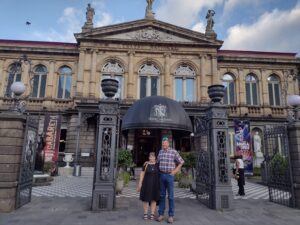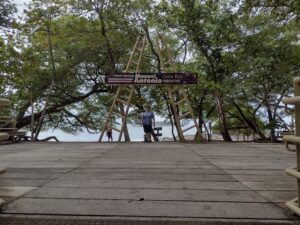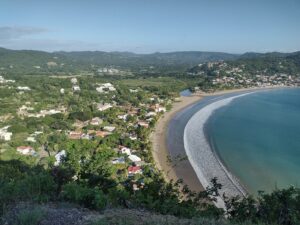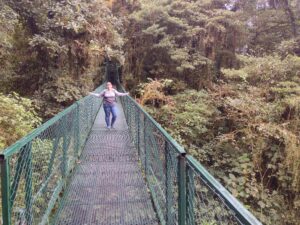Costa Rica Tips
Your Intro to International Travel
Is it inexpensive to visit Costa Rica? In addition to the usual caveats about travel style and tastes, answering this question about visiting Costa Rica requires a discussion of relativity. Costa Rica and Belize have earned reputations for being the safest places to visit in Central America. They have not suffered the coups, revolutions, or gang/cartel violence that have at times plagued their neighbors. Costa Rica does not even have a military. While people may disapprove of the current Nicaraguan government, it seems to have taken a step toward stability. El Salvador is just beginning to reap the benefits of a massive campaign to rid the country of its MS-13 infiltration, and has thus become a much safer place to visit. Guatemala and Honduras both have regions that continue to be plagued by crime rates, but also others that are quite safe and welcoming to tourists. Likewise, Mexico has many safe tourist areas while still suffering from cartel activity in wide swaths. But all of these other places lack the reputation for long term stability that makes Costa Rica and Belize more palatable, more popular, and therefore more expensive to North American travelers.
These neighboring countries offer many of the same attractions available in Costa Rica – beaches, volcanoes, tropics, and highlands. They often do so at a much lower price. Next to other parts of Central or Latin America, Costa Rica can seem expensive. Rooms, food, and activities in Costa Rica will still seem like a pretty good bargain in comparison to travel in America or Western Europe. The closer one gets to American- or European-style tourist amenities, the higher the price will become – sometimes surpassing American pricing for all inclusive luxury accommodations. On the other hand, if you stick to mom and pop restaurants and the kinds of accommodations that might be frequented by middle class Central Americans, you’ll still have a real bargain of a trip. You just might not have not water.
Food
I enjoyed the food I ate in Costa Rica. Most nights, I ate what was called “artisanal” ice cream. It seemed to be of high quality, and was always very tasty. Tostones came with most meals. I enjoyed eating tostones regularly. These were slices of fried plantain. There were a lot of local fruits available in breakfast combinations at motels. They were usually offered as an alternative to traditional Costa Rican or American breakfast fare. They seemed like a healthy option, and I often availed myself of this delicious start to my day.
Ceviche was offered at many restaurants. I am a big fan of ceviche. If it seems clear that the offering is fresh, I often choose this as at least an appetizer. I tried olla de carne (beef stew), and thought that was good. Many meals come with rice and black beans – even breakfast. Of course you can also find arroz con pollo (chicken and rice), and picadillo (diced vegetables) with many meals. Stephanie enjoyed casado, a plate with rice, black beans, plantains, salad, tortillas and beef, though sometimes other meats can be substituted. As seems to be the case in most Latin American countries, any steaks I ordered were thin and tough, but flavorful. The best meat I had in Costa Rica was a delicious Argentine-style churrasco steak. This is served with chimichurri sauce. I am a big fan, and hope to find this when I go to Argentina sometime. Argentina has been on my list for a while, and churrasco is one of the reasons.
Accommodations
As I have hinted already, the variety of types and price points for places to stay in Costa Rica is wide. I am not a luxury hotel kind of guy, so I cannot really comment on higher end places. Since Stephanie was with me on this trip, I was also aiming a bit above the hostel level. My strategy was to use airbnb.com and other booking sites to find private houses, apartments, or mom and pop type motels. In Quepos, we had a downstairs one bedroom flat with an outside sitting area, a restaurant with a bar, and a pool. It did not appear to be a luxury resort, but it was pleasant and we enjoyed our time there. We had hot water, air conditioning, and wifi. This came at a cost of $55/night, a good deal by American standards, but not the sort of bargain you would find in San Juan del Sur.
We stayed at the Hotel M&M Beach House in Playas del Coco. This is an older two story motel, just across the street from the beachfront and park. The location was great, and the room came with breakfast, and offered a laundry service for an extra charge. The price was about what we paid for our place at Quepos. The location was better and we got the morning meal thrown in, but we did not have air conditioning or hot water. There was no need for hot water, but it was warm enough at night in Guanacaste that something more than a fan would have been nice. We tolerated the temperature. We did get wifi with the room.
Our accidental stay in Rivas, Nicaragua was in safe but spartan quarters. We paid $30 for a simple room with a bed and a bathroom. We did have A/C and wifi. I couldn’t tell you if there was hot water, but I doubt it. The room probably could have been had for a lower price, but I was in no position nor mood to negotiate.
We paid a bit more for our room in Santa Elena, but got an aesthetically beautiful place. We had hot water and wifi, but no air conditioning. I do not believe any motels in Santa Elena have air conditioners. As is the case at Lake Tahoe, the feature just isn’t needed in Costa Rica’s central highlands.
We got a great deal on what had once been a high rise apartment in San Jose. The neighborhood was nice, and we enjoyed the roof top hot tub. The facility included indoor parking, air conditioning, wifi, and a practically deserted gym. It was a very nice place that was once again more on par with what you might pay in Eastern Europe. It wasn’t an American price, but it wasn’t a Central American price, either.
Transportation
I rented a car in Costa Rica. Driving in Latin American countries can be a bit of an adventure. Costa Rica has its share of aggressive drivers, but at least the road conditions in most of the country are tolerable. Still, if you’re not confident in your ability to weave through and avoid traffic, renting in Costa Rica might not be for you. I suspect the country has the standard colectivos and bus systems, but I can’t be sure, as we didn’t use them. Certainly, the resorts will have their own plush shuttles, offered at resort prices.
Money
Be prepared to do a some mental math in order to convert currency and make purchases in Costa Rica. Cash can be had readily at ATMs throughout the country, and your upscale places will take plastic cards. Many shops, street vendors, mom and pop establishments and other small scale operations will require cash. At the time of our visit, the conversion rate was ₡ 530 to the dollar. One rojo (a polymer ₡1000 note) is worth about two dollars. It can be shocking to note that a soft drink costs ₡ 800 until you realize that’s only a tad more than $1.50. In nearby Nicaragua, Cordobas traded at about 35 to the dollar. They go a lot farther, too.
Conclusion
Costa Rica is a very accessible travel destination. It could easily be a “starter trip,” if you are looking for a place to get your feet wet on the international travel scene. You can practice your Spanish, go deep sea fishing, climb volcanoes, hike the cloud forests, surf, zip line, or just hang out on the beach and sip slushy alcoholic drinks. There are definitely signs of poverty here and there, and a healthy population of stray animals. You see nothing like the box house neighborhoods of India or Nepal, however. There really aren’t even many neighborhoods that resemble the favelas we saw in Rio de Janeiro. An “off the beaten track” destination it is not. There are lots of tourists. Most Ticos understand that tourists butter their bread, and are accordingly very welcoming to visitors. Costa Rica may also be a palatable alternative to a significant other struggling with skepticism about travel to Latin America. It is a beautiful country, and well worth the low cost in time and treasure to visit. If you are feeling a bit more adventurous or have a tighter budget, many of the same activities can be had at a fraction of the price across the line in Nicaragua.





